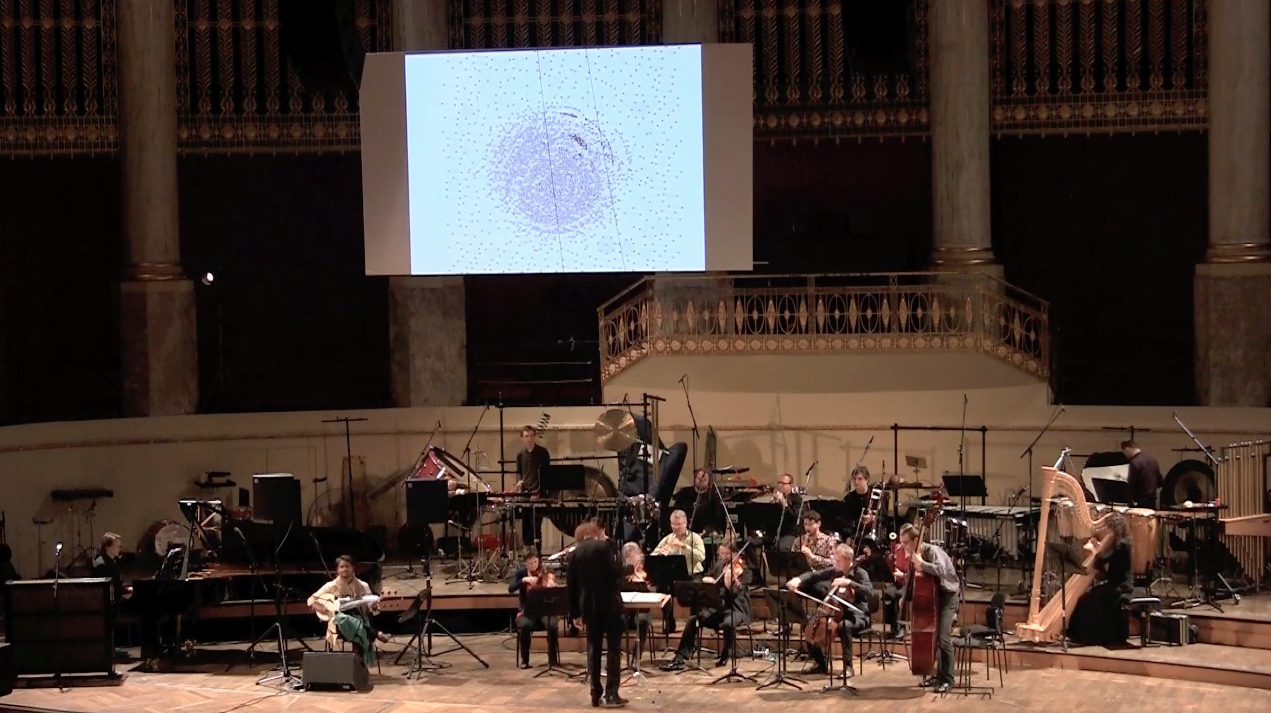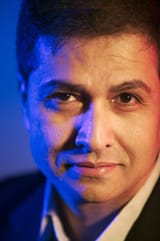EMBRACING OTHERNESS – Creating a World for Raga Fields

In order to endow a new work with value, it is not necessary to call it ‘experimental’, as if that could rubber stamp it with newness and worthiness. I am not sure that I would describe my work as ‘experimental’. Another commonly used tag for work crossing the boundaries between cultures is to label it ‘fusion’. We call something experimental when we do not know what the result will be. I have been thinking about some of the ideas behind this piece, what it should be and indeed what it shouldn’t be, for well nigh 40 years. As for fusion, it would seem I have in fact stayed away from most current notions about ‘fusion’ such as I have seen in some other works dealing with Indian and Western music. I do not believe in ‘fusion’ and agree with Ustad Amjad Ali Khan that it can lead to ‘confusion’ as he humourously put it on stage once. My work is subtitled ‘Three Spaces for Sarod and Ensemble’. I have consciously tried to create musical spaces that accommodate the musics of two different cultural traditions within a larger compositional unity. The fundamental basis of this common space consisted of creating a harmonic grid that could not only encompass the notes of a raga, but also a contemporary western harmonic spectrum. And not just one harmonic grid but several, so that multiple ragas emerge and disappear seamlessly within a harmonic flow that allows Western-style harmonic elements to also remain contemporary and informed by the harmonic innovations of the 20th and 21st centuries.
I also made it very clear to the western musicians in the ensemble, that there was no requirement for them to try to sound ‘Indian’ in style. Classical Indian music is extraordinarily idiosyncratic in technique and sound, has a unique and powerful identity. Any attempt by a musician from a Western tradition to adopt this identity merely by adding glissandi to the mix and approximately playing the notes of the raga is doomed to inadequacy. It takes years of training to learn to play a raga, and a western musician cannot approximate that in a few rehearsals. I think it is much more interesting to look for ways in which the two musics can exist side-by-side, in a common space, reflect and mirror each other in dialogue.
When people clamour for so-called fusion music, they’re looking for easy elements of musical gesture amalgamated into one cultural artefact. This often involves surface features grafted from one language onto another, and in my view this approach rarely works well. I would like to suggest that we might try to look at background structure to see what one music can learn from the structure of another. For example, there is an element of rhythm in Indian music which also exists in Western musical theory as a distant relation. I refer to the marvellous parallel between the Indian concept of tala cycles (with its Tali and Khali) and the medieval Western idea of the isorhythm, with its twin components of ‘talea ‘ and ‘color ‘. In the second movement of my work, I have underpinned the sarod playing in raga Gunkali with the trumpet in a symmetrical atonal ‘mode of limited transposition’. The underlying isorhythm of 29 rhythmic durations is somewhat akin to a 29-matra tala. But It really isn’t meant to sound ‘Indian’ as a rhythmic structure. It is a unique meeting point of both similarities and differences.
I do not doubt that there are many other ways in which common spaces between two musics can be explored. Raga Fields is certainly my first work in this direction, and I hope that there will be others in the future.
ARVE Error: need id and provider
An extract of Raga Fields from third movement ‘Vibrant’
It is an unfortunate anomaly of so many famous and well-intended ‘fusion experiments’ that these have often been done by classical Indian musicians using commercial arrangers to write the orchestral surround sound. I would like, gently, to suggest that it would be more profitable for them to work with contemporary composers, schooled in the techniques of modern harmony and orchestration. This invariably requires an openness of mind on both sides. Western music isn’t just Mozart and Beethoven. It is also Alban Berg, Igor Stravinsky, Olivier Messiaen and Gyorgy Ligeti. Just as Indian classical music isn’t merely exotic instruments playing strange scales with ubiquitous glissandi, so also western music isn’t merely triadic harmony in a major key and a foot-tapping four/four time signature. It is also modal scales, symmetrical scales, atonal harmonic fields, intervallic-ally– structured chordal formations, and rich rhythmic and orchestration techniques that sound nothing like Mozart. Are we prepared to embrace all of that?
One of the working titles of my piece was The Mirror of Otherness. To reflect upon and embrace the ‘otherness’ of a musical language and identity that is different from our own. To respectfully mirror each other with joy and grace. Not necessarily to try insistently to fuse one thing to another, but also to recognise and celebrate the differences.
About Raga Fields
Soloist(s): Sarod
Orchestration: Flute, Oboe, Clarinet, Bassoon (all with doublings), Horn, Trumpet, Trombone, Percussion (2 players), Keyboard, Harp, two Violins, Viola, Cello, Double Bass
Commissioned by: Birmingham Contemporary Music Group, Fulcrum Point New Music Projects (Chicago) and Klangforum Wien (Vienna)
Dedicated to: Randolph Coleman
Availability: Full score and Materials available from this website. Please use the Contacts Page
” . . . almost extra-terrestial . . .” The BIRMINGHAM POST, October 9, 2014
This work received its world premiere on 4 October 2014 with the BCMG and Soumik Datta, with Nicholas Collon conducting.

Photo: Conductor Stephen Burns with Soumik Datta and Param Vir in Chicago 2013 © Param Vir 2016
Whilst there have been many works attempting to ‘fuse’ Indian and Western music in the last forty years, a majority of these have ended up as a melange of Indian-style pastiche and simple Western diatonic harmonies, orchestrated in a manner reminiscent of Indian film music. Almost invariably it is the western ensemble that is short-changed, reduced to providing a backing band for the Indian soloist.
My intention in Raga Fields was to eschew such obvious solutions of crossover and to write a work with a very contemporary feel, through the harnessing of many of the resources of contemporary harmony and orchestration when writing for a Western ensemble. The result would bring contemporary Western music into a unique blend with Indian classical music. My hope was to create a dynamic new music with a rich, contemporary feel, whilst accommodating some of the techniques of Indian raga and tala within the idiomatic writing for Sarod. Is it possible to embed raga-like material with atonal harmonic fields? It most certainly is!
There were plenty of challenges to be negotiated. Creating a harmonic language, notation and form was especially challenging as the Indian Raga has a very strong identity and tends very quickly to vanquish other musical identities surrounding it if they are in opposition. To develop and coordinate these elements I undertook the work in two stages. The work first evolved as a set of sketches for chamber quintet, in skeletal form, which were rehearsed and presented in a workshop setting to develop familiarity between soloist, composer and ensemble.
These embryonic sketches were then expanded and fleshed out with full orchestration (Flute, Oboe, Clarinet, Bassoon (all with doublings), French Horn, Trumpet, Trombone, two Percussionists, Keyboard, Harp, two Violins, Viola, Cello, and Double Bass) and formal expansion so as to achieve full realisation.
Programme Note
Raga Fields
Three Spaces for Sarod and Ensemble
I Void
II Tranquil
III Vibrant
Raga Fields interlocks contemporary Western music with classical Indian musical tradition, forging a sound world capable of projecting, with intensity, the power and energy of two very different musical traditions. The diverse sides of the mix must stretch their comfort zones to reach to the ‘otherness’ of their counterpart, and to both reflect and confront each other in impassioned and sometimes jagged exchanges. Within the ensemble, modal, tonal and atonal harmonic fields embed and merge into fleeting Raga-like allusions, all encased in contemporary counterpoint and orchestration. The three spaces of the work offer the sarod soloist the opportunity to articulate a unique pathway in every live performance, with his music moving in a seamless stream from notated passages to improvisatory areas of space inhabited by traditional Ragas.
In the first space Void, the sarod music is entirely improvised, with the ensemble gradually drifting in with free-floating mobiles, spontaneously triggered by the musicians in four or five waves. The ensemble music is almost all in the higher registers, and functions as an extended and enriched idea of a drone.
In Tranquil, the sarod alternates between playing within atonal harmonic fields and traditionalragas, and offers a rich counterpoint to the ensemble, which in turn reflects and mirrors the sarod’s phrases. In the final space Vibrant, the sarod music fuses into a dramatic and high-octane mix, diving into a plethora of harmonies and tempi, and fully integrating its music within the ensemble.
The work is a mirror to the contemporary world – where monolithic cultures have given way to a melting pot of possibilities drawn from everything and everywhere. In this sometimes distorting mirror of ever-present otherness, we are challenged to view one another in new light, thereby discovering our common ground and embracing our differences.
Raga Fields was commissioned by the Birmingham Contemporary Music Group, Fulcrum Point New Music Project and Klangforum Wien. It is dedicated to my friend, the composer Randolph Coleman.
Performances
15 October 2015
Raga Fields
Royal Festival Hall
London, England
06 June 2015
Raga Fields
Muziekgebouw aan ‘t IJ
Amsterdam, Netherlands
23 May 2015
Raga Fields
Wiener Konzerthaus
Vienna, Austria
02 May 2015
Raga Fields
Kölner Philharmonie
Cologne, Germany
01 November 2014
Raga Fields
Harris Theatre
Chicago, USA
04 October 2014
Raga Fields
CBSO Centre
Birmingham, England
www.paramvir.net





